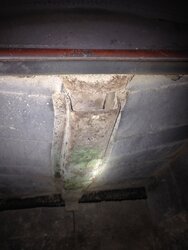when you guys are talking temperatures, WHERE are taking your temps? I assume under the trivet, as that where I see the reference temperatures taken from in the owners manual. If I remember correctly, I believe the owners manual mentions stove efficieincies are best when the stove temp as measured under the trivet are between 500-600 degrees? I use a magnetic thermometer under the trivet, and 6-8" up the stack for stack temp reference as well. For most efficient heating I would say my under trivet temps are best between 450 - 700. I find that is most commonly accomplished by setting the air input "draft knob" between 2.5 - 3.5 for most efficient operation.
I have noticed the under trivet temps ironically drop as much as 100 -200 degrees when the upper baffles have been disturbed and there is a large 3-4 inch gap between them from being bumped during loading, so those baffles make a large difference when put in place correctly !
As I stated before, I burn from October thru AprilMay depending on the temps each year. But, I CONTINUOUSLY run the stove from probably NovDec thru MarchApril. My first months using this stove last year I was constantly battling a relatively high coal�sh level that consumed too much of the fairly short firebox height. We have come up with a loading scheme that seems very effective for keeping the coal�sh levels at a minimum wile continously burning the stove through the colder months, and getting the most heat of our wood. We try and get our temps up throughout the day to accomodate the longer burn times we achieve at night by closing the damper to "1" or so . Problem is the low and long burns we do at night leaves a pile of coals that accumulate too much if you keep burning it on low, and loading front to rear. so, what we do to burn up the accumulating coals and keep the stove hot enough to burn efficiently is we burn 16" or so split logs sideways instead of front to rear in a 2 or 3 : 1 ratio. Meaning, for every long slow burn at night with logs front to rear as explained in the manual, we burn another 2 or 3 times between that with short split wood pieces turned sideways. the stove really gives off the heat this way, and burns up the accumulating coals into almost dust ash very well. In order to do this, I use my shovel or poker to move most of the coals to the left and right running front to rear, leaving an air 'tunnel" down the middle to the rear. I then set my shorter split pieces left to right, and and stack them closely, and possibly a single one on top to create a triangular stack, but sideways, spanning the air trough down the middle. I also place the first log almost 1/3 of way forward from the back of the stove for a small tight load. I came up with this idea from watching the stove throughout it's own burn cycles over months. I discovered with the stoves design of letting the inlet air in low and middle front of the firebox, the stove burns best when it burns the wood and creates a super hot middle kiln area surrounded by wood on 3 sides and possible on top. So, by creating the trough down the middle and burning shorter split pieces left to right, I am creating this same "kilnlike" tunnel, that burns hot and efficiently, and allows the coals on the left and right and rear of the box to burn completely into energy because the box temps are so high, and the air is moving across them anyways. I was even able to get my teenage son to understand it and he practices the same loading 2-3 sideways :1 front to rear ratio and we have become very comfrotable using this stove throughout the long winter heating months to comfortable heat our 2700 sq ft. house down into the single digits when managed properly.
To accomodate this sideways log placement cycle thing we do, I now cut some wood 16" , and others at 20 - 22" and stack them all together, so when we bring in wood each time, we have a good mix of sideways and front to rear logs.
This year between the blower installation, and the new loading scheme I am getting a lot more out of my stove than I did last year and our wood consumption is down as well! Before coming up with this, we had too much unburned coals and I would unfortunately have to discard some of the not so completely burned coals out with in the ash bucket, to make room for a long overnight slow burn, and that was frustrating. I am now betting the load of logs we get annualy that used to only heat our house for one year, will likely get us almost 1.5 years because of the our napoleon stove, and the way we are using it. I also stuck a mirror up my chimney last week and couldnt believe how clean it is compared to previous years with older technology, but good named brand stoves. Happy Napoloeon stove burning!


 ! Ahhhhhhhhhhhhhhhhh....... it feels so good
! Ahhhhhhhhhhhhhhhhh....... it feels so good
